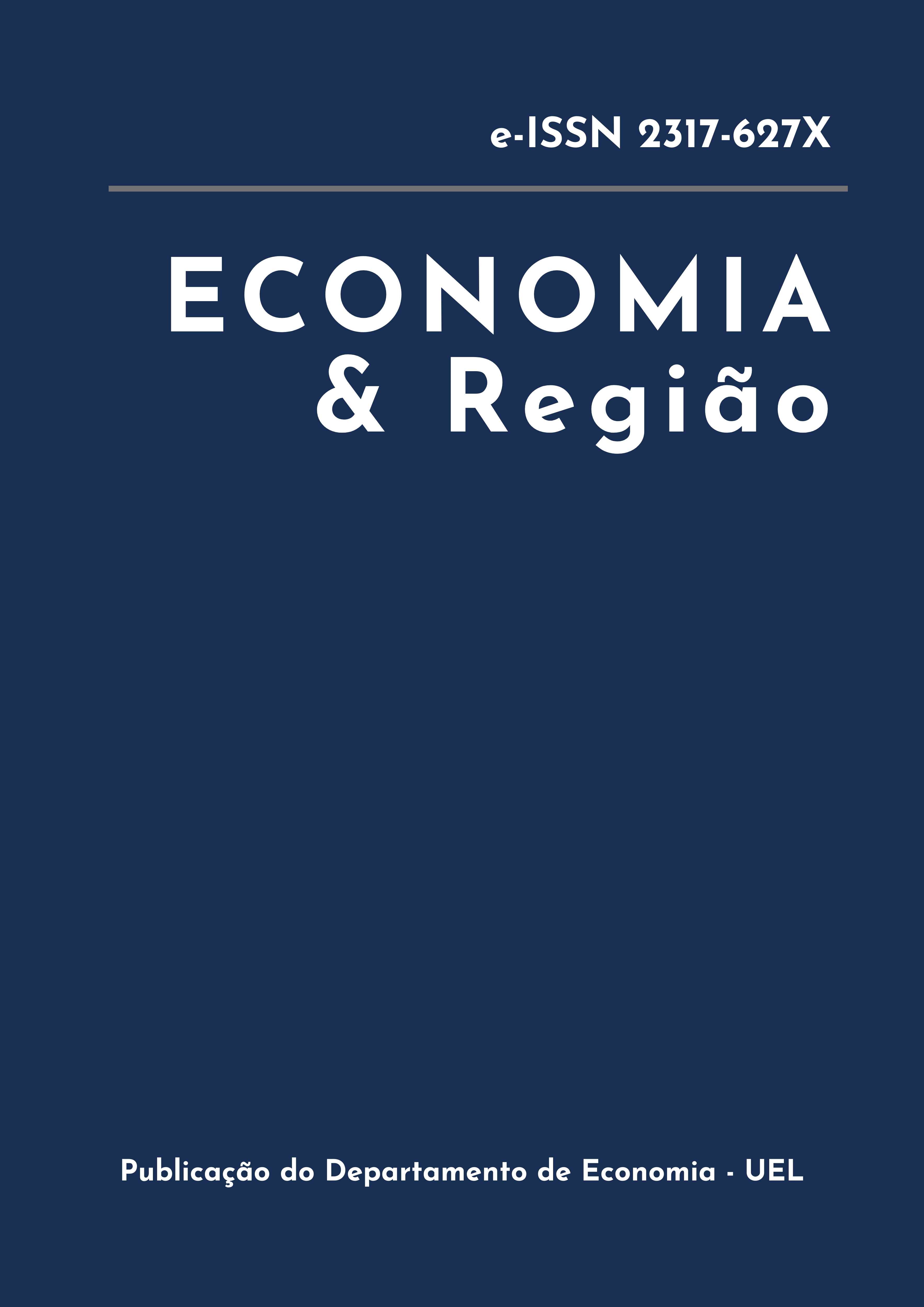The The external vulnerability of the brazilian economy in the post-2008 world economy scenario
a look in light of the structural factors of its commercial and financial insertion (2000-2017)
DOI:
https://doi.org/10.5433/2317-627X.2024.v12.n2.49135Keywords:
external vulnerability; balance of payments; productive specialization; currency hierarchy.Abstract
The present work aimed to assess the external vulnerability of the Brazilian economy in the face of the post-2008 world economic scenario, launching brief considerations about the structural factors of its commercial and financial insertion in the period 2000-2017. In order to achieve this objective, we sought not only to make a brief presentation about the main facts and issues that mark the recent scenario of the world economy, but also to take into consideration two complementary theoretical approaches: 1) the ideas of Raúl Prebisch (1949 ) about the division of the world economic system between center and periphery, and 2) the perception that the international monetary and financial system presents profound asymmetries, which derive from the existence of a hierarchy of currencies at an international level. In this sense, highlighting the deepening of uncertainties and asymmetries in the characterization of the world economy, as well as the fact that Brazil constitutes an economy specialized in products (basic and semi-manufactured) with low added value, and issuing a currency with low liquidity internationally, it was observed that the discussion of the external vulnerability of the Brazilian economy is far from being overcome, despite any improvement in cyclical indicators of external vulnerability, such as the significant volume of international reserves accumulated throughout the 2000s.
Downloads
References
AIZENMAN, J.; ITO, H. East Asian economies and financial globalization in the post-crisis world. National Bureau of Economic Research Working Paper, Cambridge, n. 22268, p. 1-34, maio 2016. DOI 10.3386/w22268
ATTÍLIO, L. A. Análise da regulação da conta de capital. Cadernos CEPEC, Belém, v. 5, n. 2, p. 4-22, fev. 2016. Disponível em: https://periodicos.ufpa.br/index.php/cepec/article/view/6896/5422. Acesso em: 23 jun. 2023.
BCB - BANCO CENTRAL DO BRASIL. Balanço de pagamentos: BPM6. Brasília, DF: Bacen, [2018]. Disponível em: http://www.bcb.gov.br/. Acesso em: 23 jun. 2018.
BIS - BANK FOR INTERNATIONAL SETTLEMENTS. 83rd annual report. BIS, Basel, n. 83, jun. 2013. Disponível em: https://www.bis.org/publ/arpdf/ar2013e.htm. Acesso em: 23 jun. 2023.
BIS - BANK FOR INTERNATIONAL SETTLEMENTS. 84th annual report. BIS, Basel, n. 84, jun. 2014. Disponível em: https://www.bis.org/publ/arpdf/ar2014e.htm. Acesso em: 23 jun. 2018.
BIS - BANK FOR INTERNATIONAL SETTLEMENTS. 85th annual report. BIS, Basel, n. 85, jun. 2015. Disponível em: https://www.bis.org/publ/arpdf/ar2015e.htm. Acesso em: 23 jun. 2018.
BIS - BANK FOR INTERNATIONAL SETTLEMENTS. BIS quarterly review: international banking and financial market developments. Basel: BIS, 2018.
BORIO, C.; SHIN, H. S. Media briefing: BIS quarterly review. BIS, Basel, mar. 2018. Disponível em: https://www.bis.org/publ/qtrpdf/r_qt1803_ontherecord.htm. Acesso em: 22 jun. 2018.
BRASIL. Ministério da Indústria, Comércio Exterior e Serviços. Estatísticas de comércio exterior. Brasília, DF: MDIC, 2018. Disponível em: http://www.mdic.gov.br. Acesso em: 22 jun. 2018.
BRESSER-PEREIRA, L. C.; RUGITSKY, F. Industrial policy and exchange rate skepticism. Cambridge Journal of Economics, Oxford, v. 42, n. 3, p. 617-632, 2018. DOI: https://doi.org/10.1093/cje/bex004
COHEN, B. J. International currency. In: COHEN, B. J. Currency power: understanding monetary rivalry. Oxford: Oxford University Press, 2015. p. 8-27.
CONTI, B. M.; PRATES, D. M.; PLIHON, D. A hierarquia monetária e suas implicações para as taxas de câmbio e de juros e a política econômica dos países periféricos. Economia e Sociedade, Campinas, v. 23, n. 2, p. 341-372, ago. 2014. DOI 10.1590/S0104-06182014000200003
CREDIT SUISSE GROUP. Getting over globalization: outlook for 2017. [Genebra]: Credit Suisse Group, 19 jan. 2017. Disponível em: https://www.credit-suisse.com/about-us-news/en/articles/media-releases/_getting-over-globalization---what-to-watch-for-in-2017--201701.html. Acesso em: 20 mar. 2018.
EICHENGREEN, B.; LOMBARDI, D. RMBI or RMBR: is the renminbi destined to become a global or regional currency?. National Bureau of Economic Research Working Paper, Cambridge, n. 21716, p. 1-34, nov. 2015. DOI 10.3386/w21716
FRITZ, B.; PRATES, D.; PAULA, L. F. Keynes at the periphery: currency hierarchy and challenges for economic policy in emerging economies. Journal of Post Keynesian Economics, Abingdon, v. 40, p. 183-202, maio 2017. DOI 10.1080/01603477.2016.1252267
FUKUYAMA, F. US against the world?: Trump's America and the new global order. Financial Times, London, 11 nov. 2016. Disponível em: https://www.ft.com/content/6a43cf54-a75d-11e6-8b69-02899e8bd9d1. Acesso em: 22 jun. 2018.
GLOBALISATION'S retreat?. The Economist, London, 25 jun. 2015. Disponível em: https://www.economist.com/buttonwoods-notebook/2015/06/25/globalisations-retreat. Acesso em: 27 maio 2018.
GONÇALVES, R. Economia política internacional: fundamentos teóricos e as relações internacionais do Brasil. Rio de Janeiro: Elsevier, 2005.
GROUP OF THIRTY. Fundamentals of central banking: lessons from the crisis. Washington, DC: G30, 2015. p. 12.
IKENBERRY, G. J. The end of liberal international order?. International Affairs, Oxford, v. 94, n. 1, p. 7-23, jan. 2018. DOI 10.1093/ia/iix241
IMF - INTERNACIONAL MONETARY FUND. World economic outlook. Washington, DC: IMF, 2016. Disponível em: http://www.imf.org/en/publications/weo. Acesso em: 27 maio 2018.
IMF - INTERNACIONAL MONETARY FUND. World economic outlook. Washington, DC: IMF, 2017. Disponível em: http://www.imf.org/en/publications/weo. Acesso em: 1 jun. 2018.
IPEA - INSTITUTO DE PESQUISA ECONÔMICA APLICADA. Ipeadata: macroeconômico. Brasília, DF: IPEA, 2018. Disponível em: http://www.ipea.gov.br. Acesso em: 20 jun. 2018.
KALDOR, N. Causes of the slow rate of economic growth of the United Kingdom. Cambridge: Cambridge University Press, 1966.
LÉLIS, M. T. C.; SILVEIRA, E. M. C.; CUNHA, A. M.; HAINES, A. E. F. Economic growth and balance-of-payments constraint in Brazil: an analysis of the 1995-2013 period. EconomiA, [Niterói], v. 19, n. 1, p. 38-56, Jan./Apr. 2017. DOI: https://doi.org/10.1016/j.econ.2017.06.002
LUND, S.; WINDHAGEN, E.; MANYIKA, J.; HÄRLE, P.; WOETZEL, L.; GOLDSHTEIN, D. The new dynamics of financial globalization. Instituto Global Mckinsey, Washington, DC, 22 ago. 2017. Disponível em: https://www.mckinsey.com/industries/financial-services/our-insights/the-new-dynamics-of-financial-globalization. Acesso em: 13 mar. 2018.
MEDEIROS, C.; SERRANO, F. Inserção externa, exportações e crescimento no Brasil. In: FERRAZ, J. C.; CROCCO, M.; ELIAS, L. A. (org.). Liberalização econômica e desenvolvimento. São Paulo: Futura, 2003. p. 324-349.
OSTRY, J. D.; GHOSH, A. R.; HABERMEIER, K.; LAEVEN, L.; CHAMON, M.; QURESHI, M. S.; KOKENYNE, A. Managing capital flows: what tools to use?. Asian Development Review, Mandaluyong City, v. 29, n. 1, p. 83-89, 2012. Disponível em: https://www.imf.org/external/pubs/ft/sdn/2011/sdn1106.pdf. Acesso em: 27 maio 2018.
OSTRY, J. D.; LOUNGANI, P.; FURCERI, D. Neoliberalism: oversold?. Finance & Development, Washington, DC, v. 53, n. 2, p. 38-41, jun. 2016. Disponível em: https://www.imf.org/external/pubs/ft/fandd/2016/06/pdf/ostry.pdf. Acesso em: 27 maio 2018.
PALLUDETO, A. W. A.; ABOUCHEDID, S. C. A hierarquia de moedas e a relação centro-periferia revisitada. In: ENCONTRO NACIONAL DA ASSOCIAÇÃO NACIONAL DOS CENTROS DE PÓS-GRADUAÇÃO EM ECONOMIA, 42., 2014, Natal. Anais [...]. Natal: ANPEC, 2014. Disponível em: https://www.anpec.org.br/encontro/2014/submissao/files_I/i7-e923374cc89126567270d9f340d65214.pdf. Acesso em: 27 maio 2018.
PRASAD, E. A middle ground: the renminbi is rising but will not rule. Finance & Development, Washington, DC, v. 54, n. 1, p. 30-31, mar. 2017. DOI 10.5089/9781475577150.022
PRATES, D. M. As assimetrias do sistema monetário e financeiro internacional. Revista de Economia Contemporânea, Rio de Janeiro, v. 9. n. 2. p. 263-288, maio/ago. 2005. DOI 10.1590/S1415-98482005000200002
PREBISCH, R. El desarrollo económico de la América Latina y algunos de sus principales problemas. In: GURRIERI, A. (org.). La obra de Prebisch en la Cepal: lecturas. Ciudad de Mexico: Fondo de Cultura Económica, 1982. p. 5-63.
RIBEIRO, F. J. S. Reavaliando a vulnerabilidade externa da economia brasileira. Brasília, DF: IPEA, 2016.
RODRIGUES, C. F. S.; LOURENÇO, A. L. C. A case for industrial policy?: forecast results from a disaggregated BOP-constrained growth model for brazilian economy (2016-2025). Revista de Economia Contemporânea, Rio de Janeiro, v. 25, n. 1, p. 1-24, 2021. DOI 10.1590/198055272512
STIGLITZ, J. E. Capital market liberalization, economic growth, and instability. World Development, Amsterdam, v. 28, n. 6, p. 1075-1086, 2000. DOI 10.1016/S0305-750X(00)00006-1
STREECK, W. How will capitalism end?. New Left Review, London, n. 87, p. 35-64, maio/jun. 2014. Disponível em: https://newleftreview.org/issues/ii87/articles/wolfgang-streeck-how-will-capitalism-end.pdf. Acesso em: 20 abr. 2018.
SUMMERS, L. U. S. Economic prospects: secular stagnation, hysteresis, and the zero lower bound. Business Economics, Berlim, v. 49, n. 2, p. 65-73, Feb. 2014. DOI: https://doi.org/10.1057/be.2014.13
THE FUTURE of liberalism: how to make sense of 2016. The Economist, London, 24 Dec. 2016. Disponível em: https://www.economist.com/leaders/2016/12/24/how-to-make-sense-of-2016. Acesso em: 27 maio 2018.
THIRLWALL, A. Economic growth in an open developing economy: the role of structure and demand. Cheltenham: Edward Elgar Publishing, 2013.
THIRLWALL, A. The balance of payments constraint as an explanation of international growth rate differences. Banca Nazionale del Lavoro Quarterly Review, Roma, v. 32, n. 128, p. 45-53, 1979. Disponível em: https://econpapers.repec.org/article/pslbnlqrr/1979_3a01.htm. Acesso em: 20 abr. 2018.
UNIDO - UNITED NATIONS INDUSTRIAL DEVELOPMENT ORGANIZATION. Competitive industrial performance index (CIP): edition 2018. Viena: UNIDO, 2018. Disponível em: http://stat.unido.org/database/CIP%202018. Acesso em: 24 June 2018.
Downloads
Published
How to Cite
Issue
Section
License
Copyright (c) 2024 Cryslãine Flavia da Silva Rodrigues

This work is licensed under a Creative Commons Attribution 4.0 International License.
Economia & Região adota a Licença Creative Commons Attribution CC-BY 4.0 International, portanto, os direitos autorais relativos aos artigos publicados são do(s) autor(es), que cedem à Revista Economia & Região o direito de exclusividade de primeira publicação.
Sob essa licença é possível: Compartilhar - copiar e redistribuir o material em qualquer suporte ou formato. Adaptar - remixar, transformar, e criar a partir do material, atribuindo o devido crédito e prover um link para a licença e indicar se mudanças foram feitas.




















